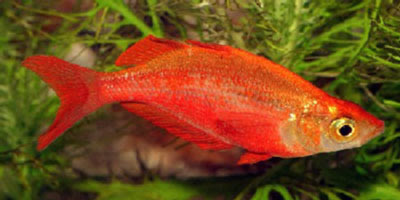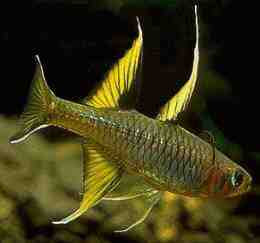Feeding Your Fish
There are hundreds of food options for your pet fish, and a combination of foods from this selection is necessary to provide your fish with the nutrients they need. All of these foods fall into two broad categorizations of fish food: live and processed, which can be broken down further as described below.
Live Fish Food
Live food consists of plants, animals, and microorganisms that are living in your tank - or at least live when you introduce them to your tank - that your fish can eat. It is important to make sure that the live foods you provide for your fish provide all the nutrients that your fish need to remain healthy and to grow properly, and do not pose a risk to the fish. Live food consists of plants, animals, and microorganisms that are living in your tank - or at least live when you introduce them to your tank - that your fish can eat. It is important to make sure that the live foods you provide for your fish provide all the nutrients that your fish need to remain healthy and to grow properly, and do not pose a risk to the fish. Many live foods, particularly feeder goldfish, are very common vectors for disease.
Many fish will graze a little on live plants and algae growing in your aquarium, but some herbivores will voraciously eat any live plants you put in the tank. Other fish will feed on microorganisms that are free-floating in your aquarium water or growing on the surface of plants and decorations. Still other fish will gladly eat worms, snails, and/or other invertebrates that are introduced to the aquarium. Many pet stores also provide a variety of insects and insect larvae that are of nutritional value to fish.
The most common live foods used in the aquarium hobby are live feeder fish. These fish often do not receive the care they need to remain healthy and are often carrying diseases or parasites that could, in turn, infect any fish that eats them. The best way to spread a disease from one fish to another is for a fish to eat an infected fish! Also, in many areas, the live foods that are available are very limited in variety. A diet of just one food is almost guaranteed to be short on some vital vitamins, minerals, or other nutrients that your fish need.
Processed Fish Food
There are many categories of processed foods, including fresh, frozen, freeze-dried, and canned.
Fresh foods include meats and vegetables with minimal processing. Many fish will go wild for small (relatively) bits of beef, poultry, seafood, or game meats, but you don't want to cook these foods in most cases. A lot of fish will also enjoy bits of fresh vegetable matter, such as raw potato, squash, zucchini, pea, bean, apple (without the peel or seeds), and spinach. Again, as with live foods, you need to make sure that the diet you have selected will meet the nutritional needs of your fish.
Frozen foods are available from most pet stores in a wide variety - from shrimp and squid to spirulina algae and vegetables to processed, vitamin enhanced staple diets to aquarium delicacies like sponges and insect larvae. The selection of frozen foods available can provide a varied and stable diet for most fish, and the processes that the foods go through when freezing greatly reduce the risk of disease transfer when compared to live foods or fresh seafood, wile maintaining a high nutritional value.
Many of the foods available as frozen foods also have a freeze-dried counterpart. These foods have all of the moisture extracted from them during processing so that they have a long shelf life and can be stored easily. Many worms, insect larvae, crustaceans, and meats are available in freeze dried forms. One disadvantage of freeze dried foods is that the freeze-drying process often strips vitamins from the food as well, so freeze dried foods are not likely to make a balanced and complete diet. Remember when feeding freeze-dried foods, that these foods can absorb a lot of water, and will fill up your fish a lot more than you would think when looking in the package. We recommend that you moisten freeze-dried foods before feeding them to your fish to keep your fish from overeating and making themselves sick.
Canned foods are often the best for a fish's staple diet. The foods are engineered to provide a complete and balanced diet for your fish and are available in a variety of forms: floating pellets, sinking pellets, granules, tablets, and flakes.
Flakes are the most common type of processed foods, and are available in a very wide variety. Some flakes are engineered to provide the nutritional requirements of specific varieties or species of fish, and others are designed to counter nutritional imbalances, Flakes are the most common type of processed foods, and are available in a very wide variety. Some flakes are engineered to provide the nutritional requirements of specific varieties or species of fish, and others are designed to counter nutritional imbalances, while still others are balanced to enhance color or growth or to encourage spawning.
Pellets are available in forms that are denser or lighter than water. This allows the fish to feed in a more natural way - if the right pellet is provided. Some fish prefer to feed off the bottom of the tank while others prefer to feed off the surface. Like flakes, pelleted foods are available in many varieties, each with a specific purpose.
Granules are like very small, hard flakes or tiny pellets. Currently only a limited variety of fish food granules are available, usually engineered for the general nutritional needs of small community fish.
Tablets are really just large flat pellets. Most tablets are of a sinking variety, but there are some that are engineered to adhere to the side of the aquarium so that you may observe your fish feeding. Most of the sinking tablets are engineered to provide for the nutritional needs of scavengers and bottom feeders.
Regardless of the type of foods you decide to feed your fish, you should provide them with a variety of foods. Variety in the diet reduces the chance of any nutritional shortcomings of one or more of your selected foods becoming a health or longevity problem for your fish. Providing a variety of foods will also reduce the chances that your fish loose interest in the foods that they are offered and go on a "hunger strike."

















